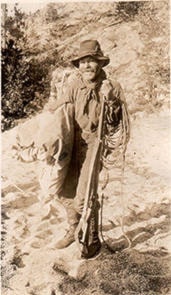Is this the face of a convicted train robber?
In May 1906, Bill Miner and two accomplices (Lewis Colquhoun and William J. “Shorty” Dunn) held up a Canadian Pacific Railway train at Ducks Station (now Monte Creek) east of Kamloops. The men were caught after a brief shoot-out between Dunn and members of the Northwest Mounted Police, and were tried for the crime in Kamloops.
Although Miner and Colquhoun were shown some leniency (Miner got 25 years), Dunn’s resistance during arrest earned him a life sentence.
Miner escaped and Colquhoun died in jail of tuberculosis. Dunn, however, remained behind bars until approximately 1918, when — with the assistance of a friend — he was paroled.
According to the Kamloops Sentinel, Dunn moved to Princeton after his release, where for a time he managed a store owned by A. J. White. He was popular with the locals, but left the area in 1921.
Provincial sources suggest Dunn died in a lake near Kamloops. Yet several old-timers here say he actually made his way to Ootsa Lake, where (according to the Prince George Citizen) he was “one of the best known trappers of that area.”
During the 1980s, former BC Provincial Police officer Cecil “Nobby” Clarke (then in his ’80s) told the Vancouver Sun that Dunn’s real name was John William (Billy) Grell. Clarke also said that after moving north, Grell/Dunn was still on parole and had to report to BC Provincial Police officer Andy Fairbairn in Telkwa once a month. Fairbairn, Clarke said, told him he liked the former robber and for that reason, kept the man’s shady past a secret.
Nevertheless, several old-timers here suspected Grell/Dunn had been in trouble with the law at some point. Yet because they liked the man, no one called him on it.
Historical records don’t provide much more detail about the reformed train robber’s life on the Southside. Yet one fact is certain: He met his end there.
John William ‘Shorty’ Grell disappeared on or about June 28, 1927 while accompanying a prospector on the Tahtsa River. The prospector, identified by the Prince George Citizen as “J. Dawson, formerly of the Standard Silver Lead Co.”, apparently managed to swim to safety after their vessel capsized, but no trace was found of his companion.
A year later, Chief Louie of Cheslatta Lake was making his way up the same waterway in the company of Tommy Jack when he found a “white man face down in the water, head up river” in a “right hand channel just below ‘hole-in-wall’.” In his statement to Cst. J.A. Johnson of the BC Provincial Police in Burns Lake, Chief Louie added that “we put willow sticks over him so he would not go away” and reported the matter to authorities.
Edward Van Tine of Ootsa Lake subsequently identified Shorty’s body. Coroner Stephen H. Hoskins of Smithers determined that ‘Shorty’ died of accidental drowning, and informed B.C.’s deputy attorney-general by letter that “it did not appear to be necessary to hold a formal inquest” into the matter.
So did convicted train robber Shorty Dunn drown in a lake near Kamloops, or meet his end in the Tahtsa River? We’ll let you be the judge.
© 2019 Michael Riis-Christianson and the Lakes District Museum Society
